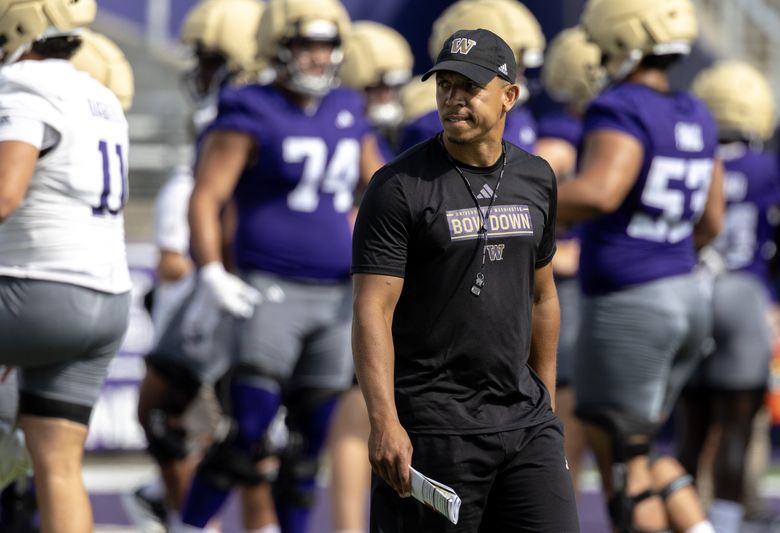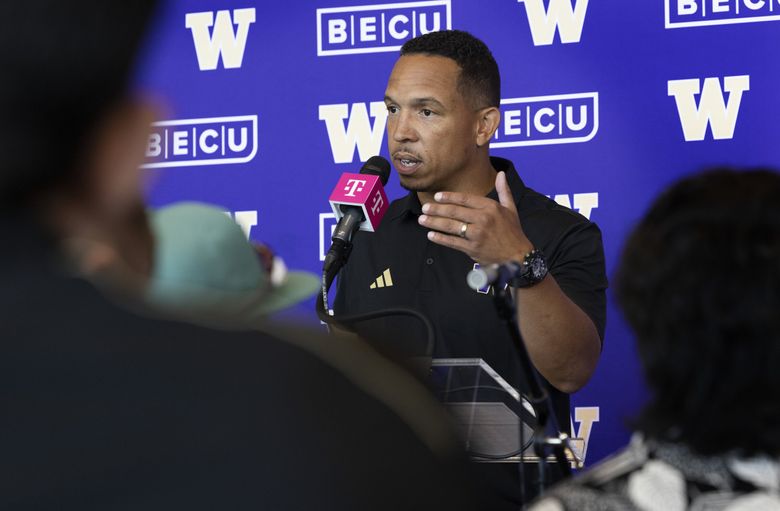
Washington defensive coordinator Ryan Walters leads defensive players in a drill during team practice, Aug. 14, 2025, in Seattle. (Nick Wagner / The Seattle Times)
Skip Ad
By Andy Yamashita Seattle Times staff reporter
Ryan Walters is uninterested in comparisons to the past.
Washington’s new defensive coordinator isn’t in Seattle to look backward. Not at his two disappointing seasons leading his own program at Purdue. Not at his two successful seasons coordinating a vaunted Illinois defense during the 2021 and 2022 seasons. Not at his meteoric ascent through the coaching ranks at Missouri after stints at Memphis, North Texas, Oklahoma and Arizona.
There are too many variables. Too many unique situations and personnel.
“Each year is different,” he said. “I don’t spend a lot of time comparing players to other players or units to other units. The focus is just on this team. This defense. This season. And how I can do my job as best as I can to put them in positions where they can have success.”
Yet Walters is on Montlake, as coach Jedd Fisch’s new defensive coordinator, because of his pedigree. At Illinois, Walters built a reputation as one of college football’s rising coaching stars by leading one of the nation’s most stingy, physical defenses.
The Fighting Illini ranked first in scoring defense in 2022 and second in total defense. Before Walters arrived, Illinois ranked 97th and 114th in scoring defense and total defense, respectively.
“He’s going to give you everything he’s got,” Xavier Scott, an Illinois defensive back and 2024 first-team All-Big Ten selection, said of playing on Walters’ team. “He’s a young coach. He’s true to his game. He’s going to find ways to get back on the road and the success level he was at when he was at Illinois.”
So what does Walters bring to Washington? At Illinois, he patented a uniquely collegiate defense constructed specifically for the challenges of playing in the Big Ten. He frequently deployed five-player defensive fronts to combat the conference’s run-heavy offenses, camouflaging his schematic looks to confuse offensive lines and trusting his defensive backs to win in man-to-man coverage.
“There’s a lot going on in a very simple look in a very simple coverage,” former UW linebacker Drew Fowler said. “To the (secondary), it’s find your man, stay on your man. You’re just giving these things that — to a defense — are simple and easy and easy to play fast, but to an offense, there’s a ton of built-in variation.
“It’s a really unique and aggressive defense.”

Washington defensive coordinator Ryan Walters during practice, July 31, 2025, in Seattle. (Nick Wagner / The Seattle Times)
A college coordinator
Since being hired at Washington, Fisch’s mantra for the Huskies has been to “Be a Pro.” The UW coach happily flaunts his NFL connections and promises his players will play in pro-style schemes on both sides of the ball. This culminated in Fisch’s hiring of Steve Belichick, who’d spent his entire career coaching with the NFL’s New England Patriots, as the team’s 2024 defensive coordinator.
Under Belichick, the Huskies struggled to stop the run or generate turnovers but held up against heavy passing attacks and showed potential for growth entering Year 2 before Belichick departed to join his father, Bill, at North Carolina.
But there are major differences between NFL offenses and collegiate ones. Most notably, how they handle space. The hash marks are much closer together on an NFL field. The distance between them — 18 feet, 6 inches — is less than half the distance between the college hash marks. So when a college offense lines up, there’s usually a wide side of the field and a short side of the field, often called the boundary side.
College offenses like to experiment with these altered dimensions, Fowler said. For example, sometimes they’ll move all of their eligible receivers into the boundary side, or the short side of the field, creating an unbalanced formation into the boundary (FIB).
Advertising Skip Ad
One benefit of an unbalanced FIB for the offense is to get a personnel mismatch. Fowler said UW’s 2023 defense, coordinated by Chuck Morrell, played a lot of cover-four zone, meaning four defenders are responsible for covering four sections of the field. When offenses went with an unbalanced FIB, the Huskies responded by pulling a linebacker out of the tackle box, often leading to a mismatch against a wide receiver. Morrell addressed this by providing safety help over the top.
But in 2024, Fowler said the Huskies often didn’t make adjustments for unbalanced FIBs because Belichick’s NFL systemnever needed to account for them at the professional level, where unbalanced FIBs don’t exist because the difference between the boundary side of the field and the wide side is negligible.
“That’s one of those things that, last year, Steve and his staff had to figure out how they wanted to do it,” Fowler said. “Because for his 20-year career, he never had to deal with that. It wasn’t a thing in New England. In college, you see it a lot more.”
Fowler noted that Walters had a different approach. The Fighting Illini played heavy doses of man coverage (meaning the defender stays with the receiver) and their defensive backs would follow receivers to the boundary side.
Additionally, Walters’ defenses mainly played in a single-high safety shell — where one deep safety, called the post safety, is positioned alone in the middle of the field — at Illinois. This allowed Walters to bring the other safety into the tackle box, closer to the line of scrimmage and cover any receivers instead of requiring a linebacker’s help. Fowler said Walters’ 2022 defense appeared “tailored” to the college game.
“The whole idea is to let linebackers be linebackers,” Fowler said, “and let DBs be DBs.”

Ryan Walters, defensive coordinator for UW football, speaks to the media during a press conference Tuesday, July 29, 2025. (Ellen M. Banner / The Seattle Times)
Five-down fronts and a diverse rush
Perhaps the most notable trait of Walters’ 2022 defense was its reliance on five-player defensive fronts, meaning five players on the line of scrimmage.
Playing with a five-down front has its benefits, Fowler said. If all five players rush the quarterback, it prevents an offensive line from double-teaming any one defender. It’s an intimidating look to call a run against for any offense. And it gives the linebacker a clearer path of vision to the ball carrier.
“It frees up a lot of the questioning of who’s coming to block me?” Fowler said. “Who’s coming to combo up to me? Because they can’t. The whole double team — 600 pounds against your nose guard — isn’t a thing anymore because they don’t have enough guys.”
The results against the run were undeniable. Illinois allowed just 99.8 yards rushing in 2022, ranking ninth nationally. Opponents managed just 3.28 yards per carry and Illinois allowed just six rushing touchdowns. For context, UW surrendered 161.8 yards rushing per game, 4.56 yards per carry and 20 touchdowns rushing in 2024.
The five-down front can also help maximize talent along the defensive line. Illinois had six interior defensive linemen who played at least 100 snaps in 2022, according to Pro Football Focus. Only Jer’Zhan “Johnny” Newton, a second-round pick, was drafted.
The five-down fronts also let Walters disguise where the pressure would come from. Fowler, while watching film of the 2022 Illinois defense, said he saw Illinois rush the quarterback with anywhere from three to six players out of the same look. Sometimes, defensive ends dropped into coverage. Other times, it was a defensive tackle. Fowler noted the linebacker covering the opposing running back frequently became a late-add blitzer if the tailback stayed in the backfield to pass protect.
All these different iterations confuse offensive lines and allow Walters to use stunts and twists effectively. If each offensive lineman expects to take the defensive lineman in front of them, Fowler said, it makes different rush patterns that already force offensive linemen to communicate even more difficult.
In past seasons, when Washington predominantly played four-down fronts, Fowler said opponents knew the Huskies were bringing extra pressure when more than four players were up at the line of scrimmage and usually audibled to quick, short passes. Walters’ regular usage of five-down fronts makes those presnap reads less predictable.
Walters’ five-down personnel varied, too, Fowler said. Sometimes, Illinois ran out three defensive tackles and two edge rushers. They occasionally played with two tackles, two edge rushers and hedged a linebacker closer to the line of scrimmage. Or they brought in two edge rushers and a nose tackle, who was flanked on the line by two linebackers.
“To an offense, it looks like every different look could be something else,” Fowler said. “So you get overwhelmed. You start overthinking. To a defense, that’s just playing fast. It’s all the same with just one or two minor adjustments.
“But it drastically changes up the picture to the entire offensive line, a quarterback and an offense.”

Illinois defensive coordinator Ryan Walters looks on before an NCAA college football game against Northwestern on Nov. 26, 2022, in Evanston, Ill. Purdue announced Tuesday, Dec. 13, 2022, they had... (Anthony Zilis/The News-Gazette via AP)
Trusting the secondary
Walters was able to consistently play five-down fronts in 2022 because he had a talented secondary that consisted of future NFL players like Quan Martin, Sydney Brown and Seahawks first-round pick Devon Witherspoon. He was comfortable leaving his defensive backs, and Witherspoon in particular, alone on islands.
Advertising Skip Ad
“If you, as a defense, can give one player to cover one guy and make it 10-on-10 football,” Fowler said, “that works in your favor.”
That talent helped turn pressure on the quarterback into turnovers. That 2022 season, Illinois tallied a 32 turnovers, including 24 interceptions. Washington managed just eight interceptions for the entire 2024 season.
Scott, who played in five games for Illinois in 2022, said Walters’ background as a defensive backs coach and as a former standout safety at Colorado meant the defensive coordinator generally knew how to keep his secondary out of bad situations. Scott also said Walters had a good understanding of the game’s flow.
“He tried to kind of just even the stress out,” Scott said. “Not too much stress on the DBs. Not too much stress on the linebackers.”
If Washington wants to recreate Walters’ Illinois scheme, it will need its secondary to hold up in man coverage. Playing a five-down defensive front inherently means one less linebacker or defensive back playing in coverage. Witherspoon and the 2022 Illinois secondary made that less of an issue by being so proficient in man coverage.
“Being able to play these kinds of man schemes,” Fowler said, “is a really valuable thing.”
Andy Yamashita: ayamashita@seattletimes .com. Andy Yamashita is a sports reporter at The Seattle Times, primarily covering Washington Huskies football.